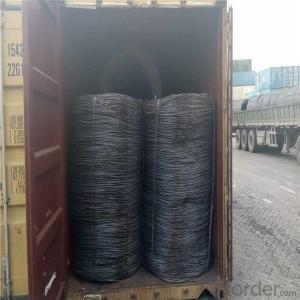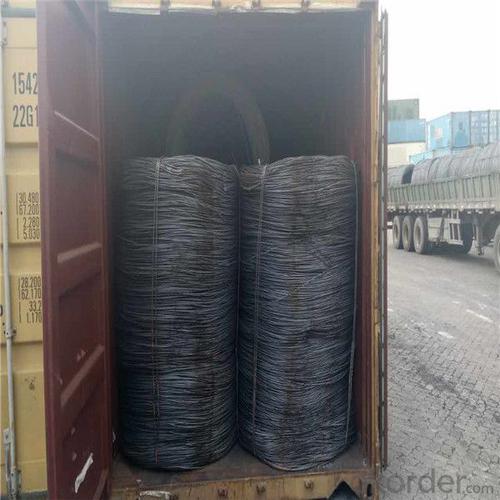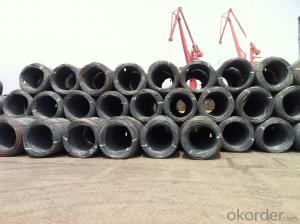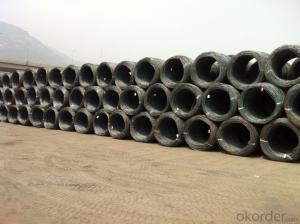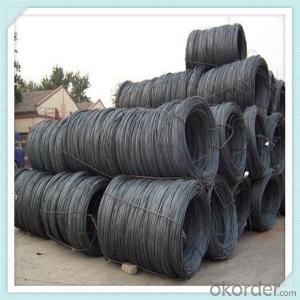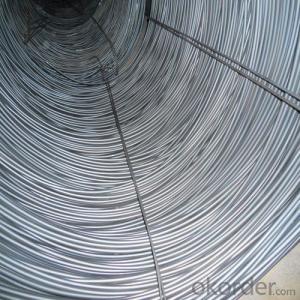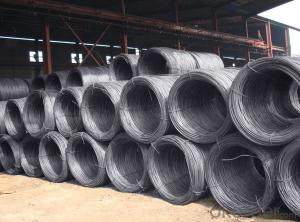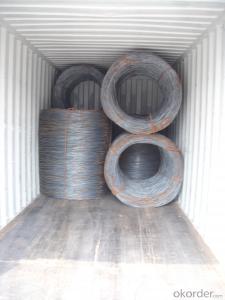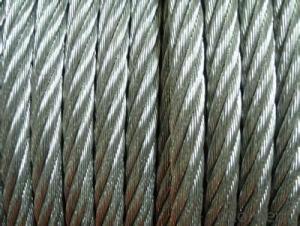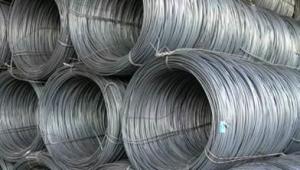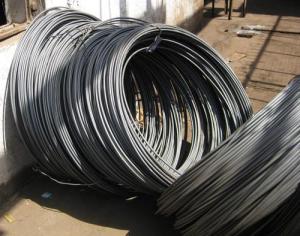Low Carbon Steel Wired Rod SAE1006 / SAE1008B
- Loading Port:
- Tianjin
- Payment Terms:
- TT OR LC
- Min Order Qty:
- 100 m.t.
- Supply Capability:
- 16472 m.t./month
OKorder Service Pledge
OKorder Financial Service
You Might Also Like
Specification
Steel wire is mainly used for prestressed and posttensioning technology in various
shapes of prestressed concrete structures,and widely used for civil engineering
construction, such as large scale railroad, highway bridges, building trusses,
overhead crane beams, industrial and prefabricated concrete floor, wall board,
tubular piles, PC water pipes, TV towers and nuclear power station, ETC. Active
strandards:GB/T5223, ASTMA421, BS5896, JISG3536, ISO6934, EN10138 or other special
required standards.
Our service:
(1) We cooperate with famous factories with advanced equipment and well trained workers.
(2) We can provide factory price with trading company service.
(3) We continuously work on the improvement of our processes, guaranteeing
consistently high standards of quality to keep none compensation.
(4) We guarantee 24 hours response and 48 hours solution providing service.
(5) We accept small order quantity before formal cooperation.
(6) We deliver the agreed quality at the agreed time, reacting to changes in
customer wishes in a flexible way.
(7) Due to our volume and selling power, we have excellent freight rates with
shipping lines.
(8) We strive to always be fair and honest in our dealings with customers.
(9) We strive to work together with customers to achieve much more than we can
achieve alone.
(10) Through our passion and commitment we aim to be a market leader in all our
key markets. To maintain our position as market leader we must continue to add
value in all that we do.
Product Description :
Standard | AISI, ASTM, BS, DIN, GB, JIS |
Material/steel grade | Q195-Q235,SAE1006B,SAE1006CR, SAE1008B, SAE1008CR, SAE1010B, SAE1018B, or according to customers requirements |
Wire Gauge | 5.5-12mm |
Coil weight | 1.8-2.1mts |
MOQ | 25MT |
Delivery Time | 15-30 days after receipt of L/C or deposit by T/T |
Packing | In coil and load in container, if large quantity, by bulk vessel; Can be packed as customers' special requirements |
Payment terms | 1).100% irrevocable L/C at sight. 2).30% T/T prepaid and the balance against the copy of B/L. 3).30% T/T prepaid and the balance against L/C |
Application | widely used in machinery parts, manufacturing industry, electronics industry, metal tools and others |
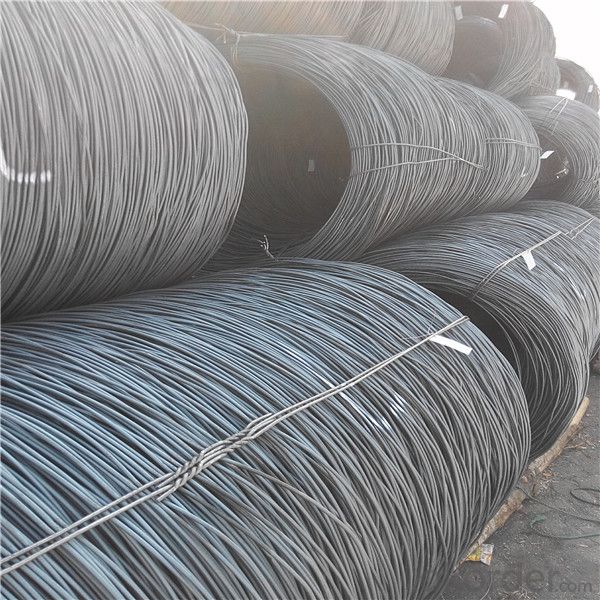
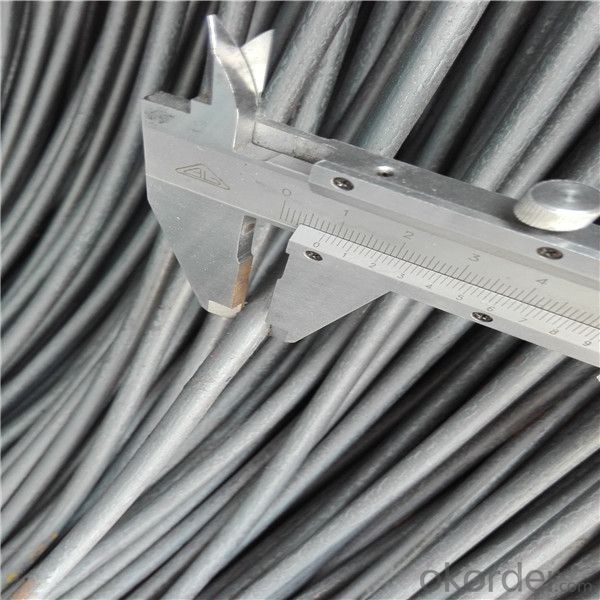
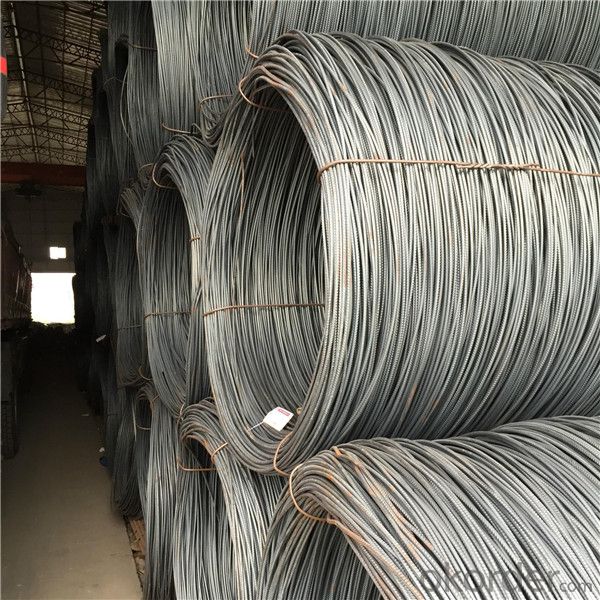
Application :
Mainly used in building and construction as binding wire, tie wire and baling wire; also can be make
for wire mesh.
Packing :
Hot-rolled wire rod is held in a unit with at least four steel straps in the
transverse direction and transported and stored without further packaging.
Before
the steel strapping is applied, the wire rod must be sufficiently compressed.
The strapping is fixed in the transverse direction with a single circumferential
strap so that the strapping does not slip and cause the coil to come apart.
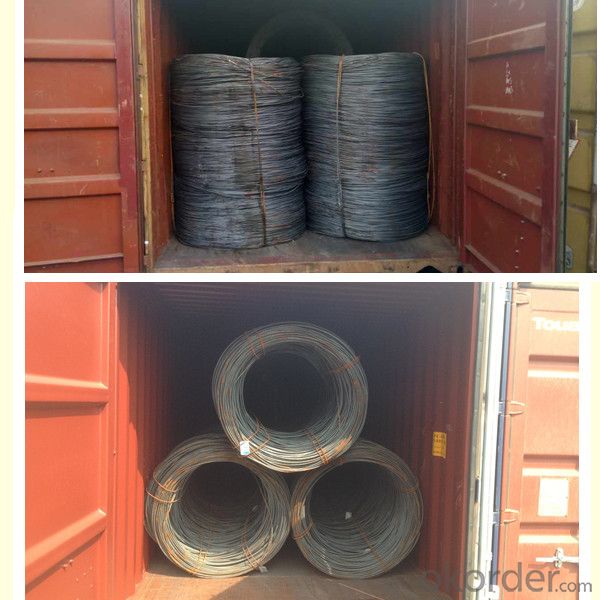
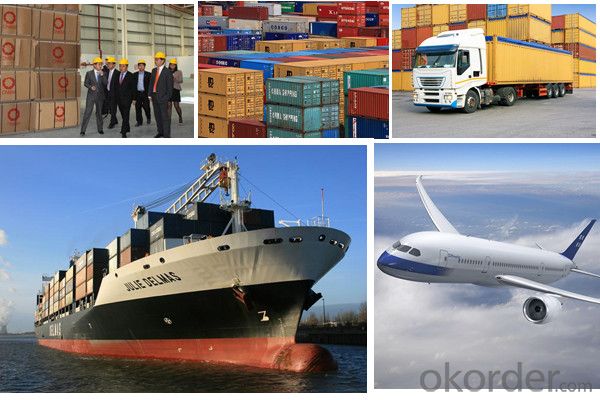
FAQ:
1.Q:Can you accept mixed order?
A: Yes, mixed acceptable .
2. Q: How can I buy CNBM products in my country?
A:Please send us an inquiry or email ,we will reply to you if there is distributor in your country
3. Q: Can we visit your factory?
A: Warmly welcome. Once we have your schedule, we will arrange the
professional sales team to follow up your case.
4. Q: How long does it take to get the product if i place an order?
A:With the process of your requirements,we will pack and deliver in 3
-7 days. If it is by sea shipment,it will take 15-45 days depending on different locations
- Q: How is steel wire rod used in the manufacturing of wire forms for recreational equipment?
- Steel wire rod is an indispensable element utilized in the production of wire forms for recreational equipment. This particular type of wire possesses remarkable tensile strength, durability, and flexibility, rendering it exceptionally suitable for fabricating a diverse range of wire forms that are commonly found in recreational equipment, including playground structures, sports gear, and outdoor fixtures. To ensure its quality and desired properties, steel wire rod undergoes a series of initial processing steps during the production of wire forms for recreational equipment. The wire rod is initially drawn through a sequence of dies, which serves to diminish its diameter while simultaneously enhancing its length. This process, commonly referred to as wire drawing, culminates in the creation of a wire that is uniform in size and possesses improved tensile strength. Following the drawing process, the steel wire rod can be further manipulated to generate various wire forms. For example, it can be subjected to bending, cutting, or welding techniques to form intricate shapes that are indispensable for specific recreational equipment. The inherent flexibility of steel wire rod enables the production of a wide array of wire forms, such as loops, hooks, rings, and coils, all of which serve as critical components in diverse recreational equipment. Subsequently, these wire forms, crafted from steel wire rod, are incorporated into the manufacturing process of recreational equipment. In the case of playground structures, steel wire rod is employed to fabricate sturdy and secure loops or hooks, which function to connect different components together, thereby imparting stability and strength to the overall structure. Similarly, in sports gear, steel wire rod is frequently utilized to fashion resilient and enduring frames for items such as basketball hoops, soccer goals, and fencing materials. Furthermore, steel wire rod finds application in the production of wire forms for outdoor fixtures, including swings, hammocks, and bike racks. These wire forms are engineered to withstand continuous usage, exposure to inclement weather conditions, and heavy loads. By employing steel wire rod, these wire forms are endowed with robustness, dependability, and long-lasting performance, thereby ensuring the safety and enjoyment of users. To sum up, steel wire rod occupies a pivotal role in the manufacturing of wire forms for recreational equipment. Its exceptional tensile strength, durability, and flexibility render it the preferred choice for producing diverse wire forms that serve as essential components in recreational equipment, imparting stability, strength, and safety to users.
- Q: How is steel wire rod used in the manufacturing of wire forms for elevator shafts?
- Steel wire rod is an essential component in the manufacturing of wire forms for elevator shafts. Elevator shafts require strong and durable materials to ensure the safety and reliability of the elevator system. Steel wire rod, which is a long cylindrical steel product, is commonly used in this process due to its inherent strength and flexibility. Firstly, steel wire rod is used as the primary raw material for manufacturing wire forms for elevator shafts. The wire rod undergoes several processes, including drawing, annealing, and surface treatment, to enhance its mechanical properties and surface finish. These processes help to refine the steel wire rod and make it suitable for further manufacturing. Once the steel wire rod is prepared, it is formed into various wire shapes that are specifically designed for elevator shafts. These wire forms can include guide rails, safety ropes, suspension cables, and counterweight ropes, among others. Each wire form serves a crucial function in the elevator system, contributing to its smooth operation and ensuring the safety of passengers. The wire forms made from steel wire rod are known for their high tensile strength, which is essential for withstanding the heavy loads and constant movement experienced by elevator systems. The wires must be able to support the weight of the elevator car and its occupants while maintaining their structural integrity over time. Steel wire rod provides the necessary strength and durability to meet these requirements. Furthermore, steel wire rod offers excellent flexibility and elasticity, allowing the wire forms to withstand the dynamic movements of the elevator system. Elevators experience constant vertical and horizontal motions, as well as vibrations, which can put stress on the wire forms. Steel wire rod's flexibility helps to absorb and distribute these forces, reducing the risk of damage or failure. In addition to its mechanical properties, steel wire rod is also corrosion-resistant, providing long-lasting performance in elevator shafts. Elevator systems are often exposed to various environmental factors, such as humidity and temperature changes, which can cause corrosion and deterioration. By using steel wire rod, manufacturers can ensure that the wire forms will remain reliable and safe for an extended period. In conclusion, steel wire rod plays a vital role in the manufacturing of wire forms for elevator shafts. Its high tensile strength, flexibility, and corrosion resistance make it an ideal material for producing wire forms that can withstand the demanding conditions of elevator systems. By utilizing steel wire rod, manufacturers can create safe and durable wire forms that contribute to the smooth operation of elevators and the security of passengers.
- Q: What are the different types of steel wire rod finishes for aesthetic purposes?
- There are several different types of steel wire rod finishes that can be used for aesthetic purposes. Some common finishes include polished, brushed, matte, and textured. These finishes can enhance the appearance of the steel wire rod and provide a desired visual effect for various applications.
- Q: What are the different types of steel wire rod surface finishes after wire drawing?
- After wire drawing, there are several different types of steel wire rod surface finishes that can be achieved. These finishes are often used to enhance the appearance and performance of the wire, as well as to protect it from corrosion and other environmental factors. Some of the most common types of steel wire rod surface finishes include: 1. Bright finish: This is the most basic type of finish, where the wire is left in its natural state after wire drawing. It has a shiny, reflective surface and is often used for applications where aesthetics are not a major concern. 2. Galvanized finish: In this finish, the wire is coated with a layer of zinc to protect it from corrosion. Galvanized wire has a dull, matte appearance and is commonly used in outdoor applications where the wire will be exposed to moisture and other harsh conditions. 3. Phosphated finish: Phosphating is a chemical process where the wire is treated with a phosphate coating to improve its corrosion resistance and adhesion properties. This finish is often used in applications where the wire will be subjected to high temperatures or corrosive environments. 4. Coated finish: In this finish, the wire is coated with a layer of polymer or other protective material. Coated wire has a smooth, uniform surface and is commonly used in applications where the wire needs to be insulated or protected from abrasion. 5. Nickel-plated finish: In this finish, the wire is coated with a layer of nickel to enhance its corrosion resistance and improve its appearance. Nickel-plated wire has a bright, shiny surface and is often used in decorative applications or in environments where the wire will be exposed to moisture and corrosive substances. These are just a few examples of the different types of steel wire rod surface finishes that can be achieved after wire drawing. The choice of finish will depend on the specific requirements of the application and the desired properties of the wire.
- Q: What are the factors that affect the cost of steel wire rod?
- The cost of steel wire rod can be affected by several factors. Firstly, the price of the raw materials used to produce steel wire rod, such as iron ore and scrap metal, heavily influences its cost. Any fluctuations in these raw material prices can directly impact the cost of steel wire rod. Secondly, the cost of producing steel wire rod includes various expenses like labor, energy, and equipment maintenance. Changes in these production and manufacturing costs can affect the overall cost of the product. Thirdly, the demand for steel wire rod plays a significant role in its cost. If there is high demand and limited supply, the price of steel wire rod may increase. Conversely, if there is low demand and excess supply, the price may decrease. Furthermore, market competition among steel wire rod manufacturers can also impact its cost. Intense competition can lead to lower prices as companies strive to attract customers. Conversely, a lack of competition may result in higher prices. Additionally, the cost of transporting steel wire rod from manufacturers to end-users contributes to its overall cost. Factors such as fuel prices, distance, and transportation infrastructure can affect these costs. Moreover, government regulations and policies, like import duties, export restrictions, or environmental regulations, can impact the cost of steel wire rod. Compliance with these regulations may require additional investments, influencing the product's price. Lastly, exchange rate fluctuations can impact the cost of steel wire rod in different countries. Changes in currency values can affect the import and export prices of steel wire rod, influencing its overall cost. To make informed decisions and strategies regarding the cost of steel wire rod, businesses should monitor and understand these factors.
- Q: Can steel wire rod be used in the production of reinforcing bars?
- Yes, steel wire rod can be used in the production of reinforcing bars. Reinforcing bars, also known as rebar, are used to strengthen and reinforce concrete structures such as buildings, bridges, and highways. Steel wire rod is a raw material that can be used in the manufacturing process to produce rebar. The wire rod is typically made from high-quality steel and is drawn into the desired thickness and shape to meet the specific requirements for reinforcing bars. It provides the necessary strength and durability to enhance the structural integrity of concrete and prevent cracking or failure. Therefore, steel wire rod is a fundamental component in the production of reinforcing bars.
- Q: How is steel wire rod used in the manufacturing of wire fences?
- Steel wire rod is used in the manufacturing of wire fences as it serves as the base material for creating the wire strands that form the fence. The wire rod is first drawn to the desired thickness and strength, and then it is further processed to form individual wires that are twisted or woven together to create the fence structure. The high strength and durability of steel wire rod make it an ideal choice for wire fences, providing security, containment, and longevity.
- Q: What are the factors affecting the price of steel wire rods?
- There are several factors that can affect the price of steel wire rods. These include the cost of raw materials such as iron ore and scrap metal, the demand and supply dynamics in the market, fluctuations in currency exchange rates, government policies and regulations, and the overall economic conditions. Additionally, factors such as production costs, energy prices, and transportation costs can also impact the price of steel wire rods.
- Q: How is steel wire rod used in the production of wire mesh for automotive applications?
- Steel wire rod is a crucial component in the production of wire mesh for automotive applications. It serves as the raw material that is drawn into thinner wires, which are then woven or welded together to create the wire mesh. This mesh is used in various automotive applications such as reinforcing car seats, creating protective barriers, and forming sturdy grilles. The strength and durability of steel wire rod make it an ideal choice for manufacturing wire mesh, ensuring the safety and reliability of automotive components.
- Q: How is the tensile strength of steel wire rod tested?
- The tensile strength of steel wire rod is typically tested using a method called the tensile test or the tension test. This test is performed to determine the maximum load or force that the wire rod can withstand before it breaks or fails under tension. In the tensile test, a representative sample of the steel wire rod is prepared by cutting it into a specific length. The sample is then placed in a testing machine called a tensile testing machine or universal testing machine. This machine consists of two jaws, one stationary and one movable, which grip the ends of the wire rod securely. Once the sample is properly positioned in the testing machine, the movable jaw is pulled away from the stationary jaw, exerting a gradually increasing force on the wire rod. The machine measures the force applied to the sample and simultaneously records the resulting elongation or deformation of the wire rod. During the test, the force and the elongation are continuously monitored until the wire rod fractures. The maximum force applied just before the fracture occurs is recorded as the tensile strength of the steel wire rod. This tensile strength value indicates the maximum load or stress that the wire rod can endure without breaking. To ensure accurate and reliable results, multiple samples are usually tested to account for any variability in the material properties. The average of these results is then taken as the representative tensile strength of the steel wire rod. Overall, the tensile strength of steel wire rod is determined through a controlled testing process using a tensile testing machine, which measures the maximum force applied to the sample before it fractures, providing valuable information about the material's strength and performance.
Send your message to us
Low Carbon Steel Wired Rod SAE1006 / SAE1008B
- Loading Port:
- Tianjin
- Payment Terms:
- TT OR LC
- Min Order Qty:
- 100 m.t.
- Supply Capability:
- 16472 m.t./month
OKorder Service Pledge
OKorder Financial Service
Similar products
Hot products
Hot Searches
Related keywords
